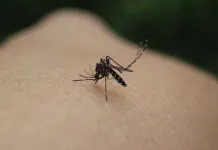(Press-News.org) UNIVERSITY PARK, Pa. — The historically high heat waves that gripped the southwest United States and southern Europe this summer are causing problems for more than just humans. Extreme heat waves affect pollinators and the pathogens that live on them, creating a mutual imbalance that could have major economic and public health consequences.
A global research team led by Penn State was the first to study how extreme heat waves affect the host-pathogen relationship between two species of solitary bees (Osmia cornifrons and Osmia lignaria) and a protozoan pathogen (Crithidia mellificae). The researchers recently published their findings in the journal Frontiers in Ecology and Evolution.
The researchers found that the one-two punch of extreme heat exposure and prior infection led solitary bees, which account for over 90% of the roughly 4,000 species of bees in North America, to be less likely to forage for food. If bees don’t forage, they don’t eat, and importantly for humans, they don’t pollinate crops that are vital to the global economy and food security.
“We are now experiencing the highest temperatures in recorded history,” said Mitzy Porras, a postdoctoral researcher in Penn State’s College of Agricultural Sciences and lead author of the study. “These heat waves are lasting three, or even four days, which is a long period of heat tolerance for bees. Then, when you combine that with prior infection from a pathogen, we’re looking at two factors that can severely negatively impact pollinator populations.”
The researchers devised an experimental method for testing what she calls “thermal boldness,” the amount of heat a bee can withstand in order to move to a food source. The bees were placed in a tunnel. On one side of the tunnel was a chamber with temperatures akin to what would be experienced in a summer heat wave and on the other side of the hot chamber was a meal of sugar water and pollen. They found that bees, which had previously been infected with a common protozoan pathogen, were far less tolerant of heat and much less likely to take the risk of passing through the chamber to eat.
In general, they found that the heat negatively impacted both the bee host and its pathogen, but the host bore the brunt of it. Exposure to heat decreased the bees’ thermal boldness and their heat tolerance, whereas the pathogen’s growth rate was only slightly negatively affected by heat.
“These asymmetrical relationships between organisms are often overlooked when studying climate impacts, but they are essential if we want to understand what is really going on,” Porras said. “When we looked at the host and pathogen in tandem, we found that infection greatly reduces heat tolerance in the host — a finding we wouldn’t have discovered if we had only been studying bees.”
The researchers found that a healthy bee could tolerate a heat wave of 109.4 degrees Fahrenheit, but after infection its tolerance was reduced to 98.6 degrees Fahrenheit.
“Our results shed light on the implications of extreme heat waves on host–pathogen dynamics under a warmer world,” said co-author Ed Rajotte, professor emeritus of entomology at Penn State. “We’re not going to see a simple, linear change as the climate warms. Every organism will respond differently and the relationships between organisms will be fundamentally altered. If we’re going to try to predict the impacts of climate change, relationships matter. There are real consequences to changes in our ecosystems and we must understand the subtleties if we are going to prepare ourselves for the reality of a changing climate.”
Solitary bees, often called the workhorses of the pollinator world due to their high foraging capacity, live for roughly a year, but are only active outside their nests for two to four weeks, for example, in early spring. They do a lifetime of pollinating in less than a month, Rajotte explained.
For humans, a three or four-day heat wave may just be an uncomfortable blip, but for a solitary bee, it can represent a quarter of the total time they are active outside their nests — and can severely affect their fitness for mating, pollinating and producing offspring. The researchers demonstrated that their health is even further jeopardized if they have been previously infected with a pathogen.
The team concluded that extreme heat exposure reduces the bees’ heat tolerance generally, but heat waves exacerbated the adverse effects of infection on the bees’ thermal physiology and ultimately affected their behavior.
“We have to think about the big picture,” Porras said. “Climate change is not just impacting species; it is impacting the relationships between species and that could have huge implications for human health and the planet as a whole.”
Other Penn State co-authors on the paper are David Biddinger and Sharifa Crandall. The other authors are Carlos Navas and Gustavo Agudelo-Cantero of the University of São Paulo; Michel Geovanni Santiago-Martínez of the University of Connecticut; and Volker Loeschcke and Jesper Givskov Sørensen of Aarhus University in Denmark.
END
Bee populations at risk of one-two punch from heat waves, pathogen infection
2023-08-16
ELSE PRESS RELEASES FROM THIS DATE:
Brinter joins RegenMed Hub
2023-08-16
WINSTON-SALEM, NC, August 2023 – Brinter Bio-Implant company joined the RegeneratOR’s Innovation Accelerator in 2023, located in the Regenerative Medicine Hub (RegenMed Hub), a rapidly growing regenerative medicine ecosystem based in the Innovation Quarter, in Winston-Salem.
Brinter is developing the world’s first personalized 3D bioprinted implants for meniscus repair using the company’s patented 3D bioprinting technology. The company’s bioprinters use a modular multi-material 3D bioprinting platform scalable from manual ...
Researchers achieve high-speed super-resolution imaging with a large field of view
2023-08-16
WASHINGTON — Researchers have developed a fluorescence microscope that uses structured illumination for fast super-resolution imaging over a wide field of view. The new microscope was designed to image multiple living cells simultaneously with a very high resolution to study the effects of various drugs and mixtures of drugs on the body.
“Polypharmacy — the effect of the many combinations of drugs typically prescribed to the chronically sick or elderly — can lead to dangerous interactions and is becoming a major issue,” said Henning Ortkrass ...
Attitudes toward minorities with dual social identities appear to be driven more by the positive influence of the shared identity than the potential negative influence of the unshared foreign identity
2023-08-16
In a new study, the attitudes of non-Muslim American participants towards Muslim Americans who identified strongly with both parts of their dual identity—Muslim and American—were just as positive as their attitudes towards Muslim Americans who identified only as American. In addition, exposure to dual-identified Muslim Americans was linked to more positive attitudes towards non-American Muslims. The same was also found in the American-Mexican context. Aharon Levy of Columbia University and Yale University, US, and colleagues present these findings in the open-access journal PLOS ONE on August 16, 2023.
Many prior studies have shown that people tend to have positive attitudes ...
Mosquito nets treated with multiple insecticides can control malaria when pyrethroid resistance leads normal nets to fail
2023-08-16
Mosquito nets treated with multiple insecticides can control malaria when pyrethroid resistance leads normal nets to fail
###
Article URL: https://journals.plos.org/plosone/article?id=10.1371/journal.pone.0289469
Article Title: Effectiveness of dual active ingredient insecticide-treated nets in preventing malaria: A systematic review and meta-analysis
Author Countries: Australia, USA, Malawi
Funding: This work was funded by the World Health Organisation, APW202903809 The funder of the study had a role in the development of the protocol, the wording and development of the review questions, the interpretation ...
Good dogs: owners of recently-adopted shelter dogs tend to report high satisfaction with their new pet despite also reporting increases in problem behavior over time
2023-08-16
Shelter dogs followed at their new homes for six months post-adoption were reported as showing more behaviors like stranger aggression or training problems by the end of the study—but owner satisfaction remained high, with 94 percent of owners reporting their dog’s behavior as excellent or good, according to a study published August 16, 2023 in the open-access journal PLOS ONE by Kyle Bohland from the Ohio State University, US, and colleagues.
Although two million dogs are adopted from US shelters every year, very little research has been done on shelter dog behavior after placement into a home. Bohland and colleagues surveyed ...
Study uncovers impact of 1918 “Spanish flu” pandemic on infant health
2023-08-16
In the wake of the 1918/1919 “Spanish flu” influenza pandemic, the probability of low birth weight and stillbirth increased among women in Switzerland, according to a new study published this week in the open-access journal PLOS ONE Kaspar Staub of the University of Zurich, Switzerland, and colleagues.
Impaired neonatal health is an ongoing public health concern worldwide. Understanding determinants that impede normal fetal and infant development and growth is crucial for ameliorating neonatal ...
Schizophrenia genetic risk factor impairs mitochondrial function
2023-08-16
Researchers at Rutgers and Emory University are gaining insights into how schizophrenia develops by studying the strongest-known genetic risk factor.
When a small portion of Chromosome 3 is missing – known as 3q29 deletion syndrome – it increases the risk for schizophrenia by about 40 fold. Researchers have now analyzed overlapping patterns of altered gene activity in two models of 3q29 deletion syndrome, including mice where the deletion has been engineered in using CRIPSR, and human brain organoids, or three-dimensional tissue cultures used to study disease. These two systems both exhibit impaired mitochondrial ...
Greater excess mortality after hurricanes more recently and for most socially vulnerable in the U.S.
2023-08-16
Over recent decades, there was a large variation in cyclone-related excess deaths by hurricane, state, county, year, and social vulnerability for counties in the United States, with 83 percent of hurricane-related deaths occurring more recently and 94 percent in more socially vulnerable counties. Results of a study by researchers at Columbia University Mailman School of Public Health, Colorado State University, Imperial College London, University of California Irvine, and Harvard T. H. Chan School of Public Health are published in the journal Science ...
Research informs WHO malaria net guideline update
2023-08-16
The World Health Organisation (WHO) has updated its recommendation for malaria-preventing mosquito nets based on new research from the University of Adelaide.
Dr Timothy Barker, of the JBI Adelaide GRADE Centre, located at the University of Adelaide, led a team which proved the effectiveness of a combination of insecticides when used to treat malaria-preventing mosquito nets.
Mosquito nets treated with pyrethroid insecticides have been distributed into malaria-prone regions globally since 2005, but some mosquito populations have developed a resistance to the substance.
“The number of malaria cases actually ...
What role do dust storms play in the world’s climate?
2023-08-16
Giant dust storms in the Gulf of Alaska can last for many days and send tonnes of fine sediment or silt into the atmosphere, and it is having an impact on the global climate system, say scientists.
The storms are so extensive they can be seen by satellites orbiting the Earth. An image captured by the Landsat satellite in 2020 shows dust blowing out of the valley and over Alaska’s south coast.
Exactly how the dust may be influencing the global climate system is not yet clear, although new research from the University of Leeds and the National Centre for Atmospheric ...





